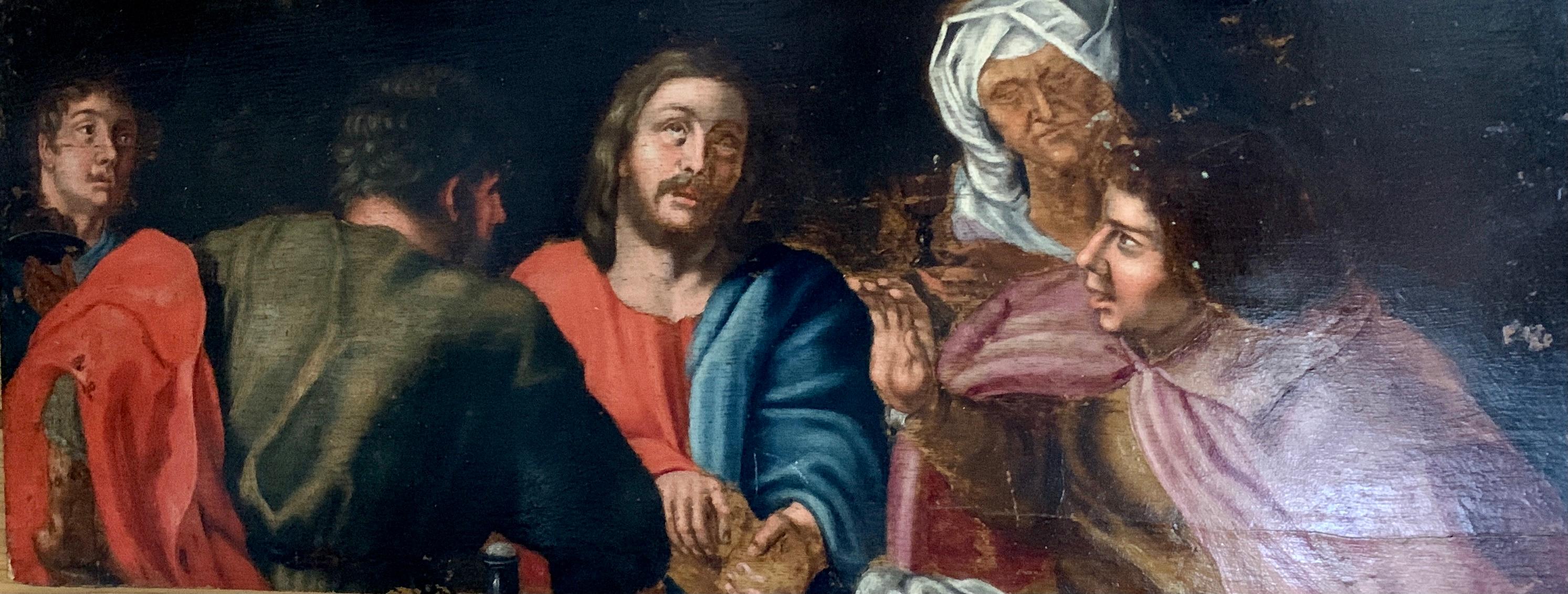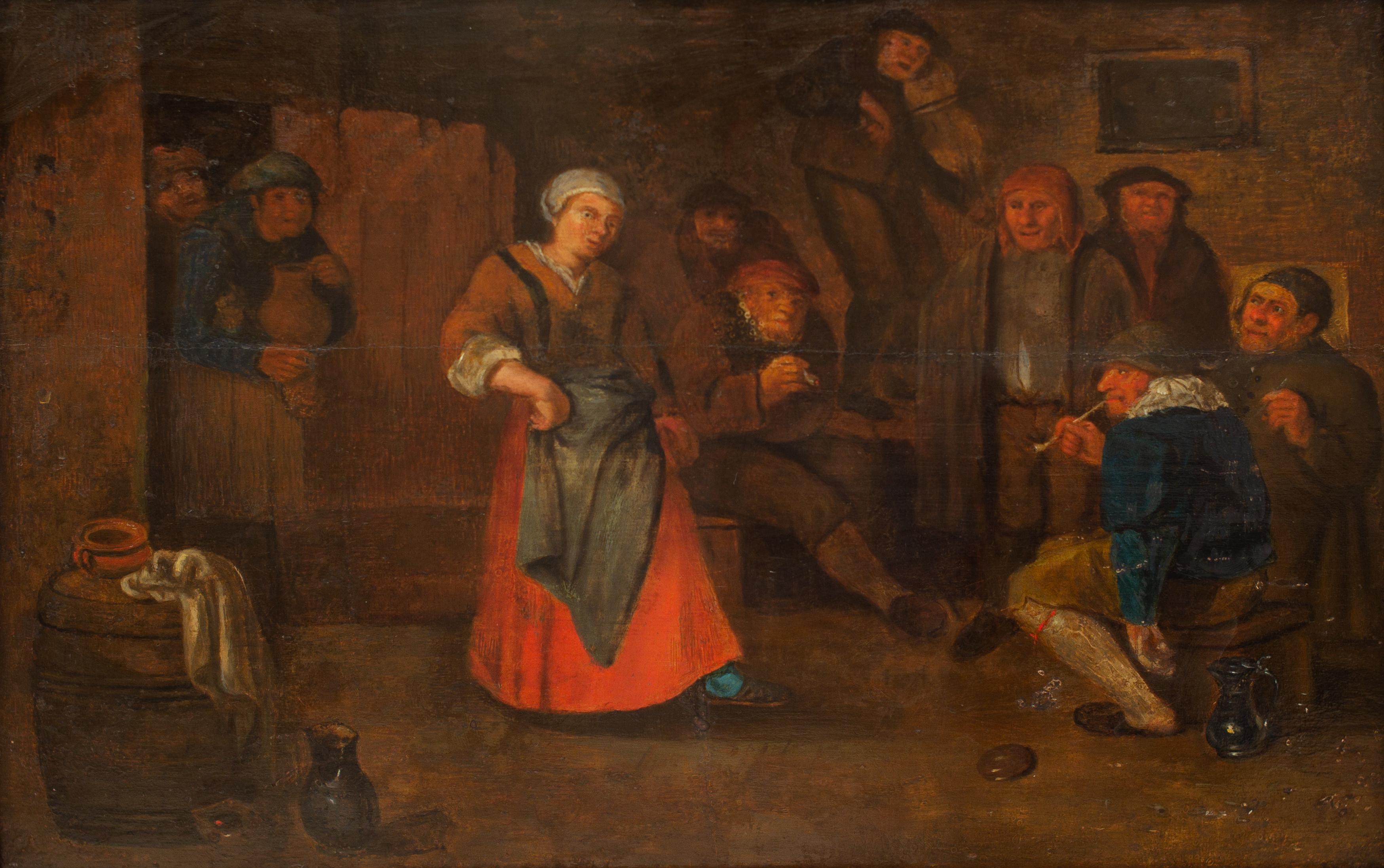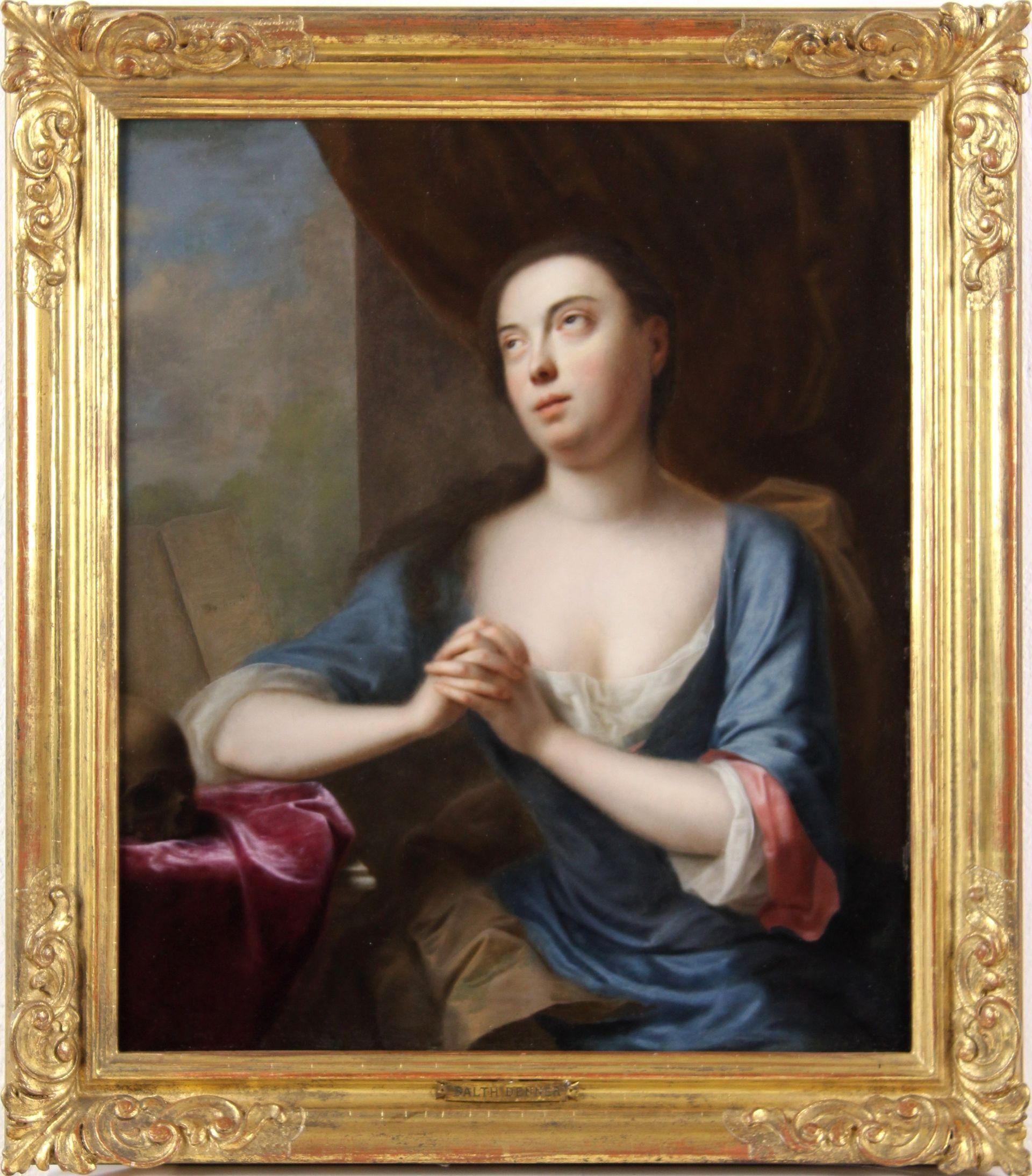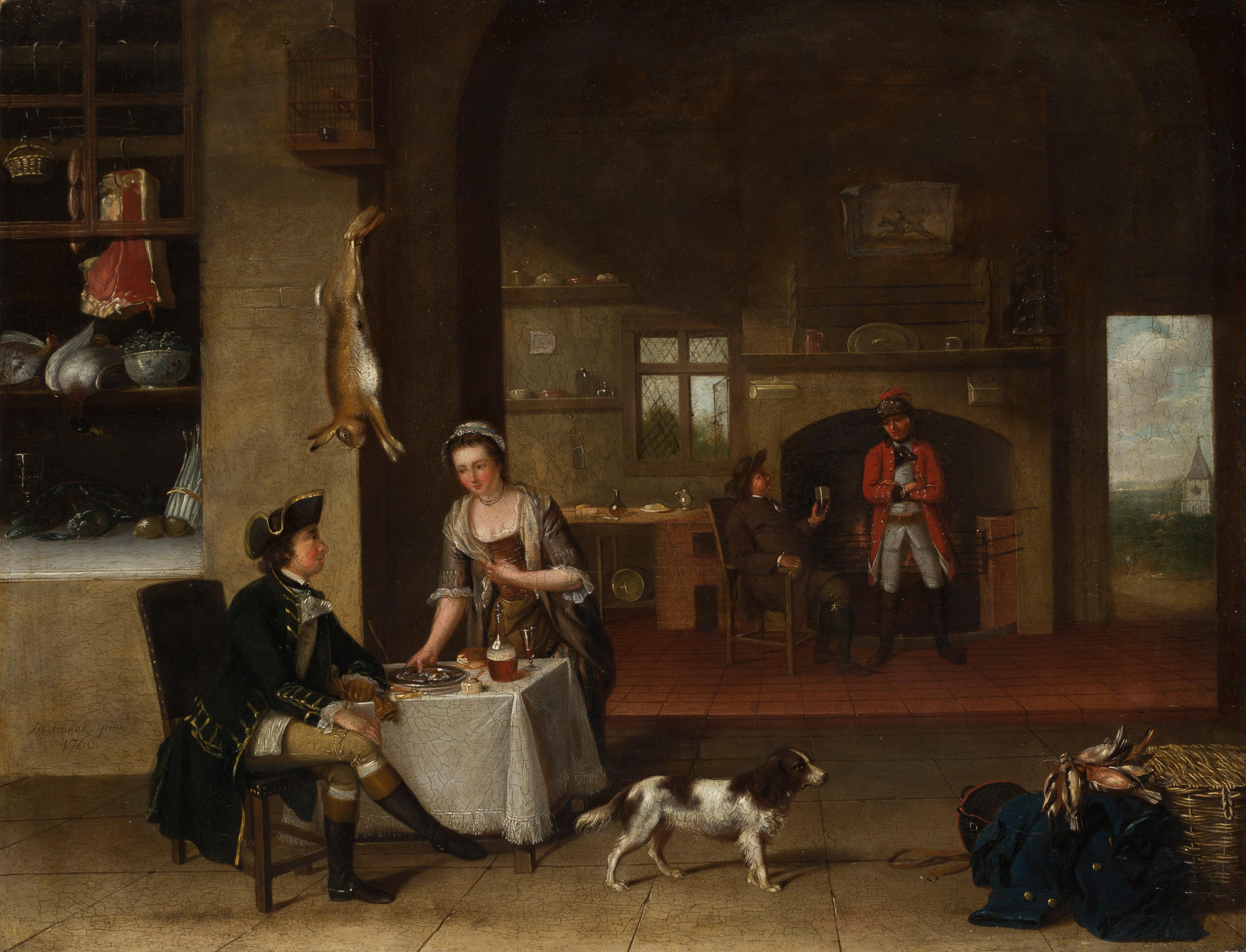Items Similar to Dutch 17th Century Oil Painting - The Card Game by Ter Borch
Want more images or videos?
Request additional images or videos from the seller
1 of 7
Gerard ter Borch the YoungerDutch 17th Century Oil Painting - The Card Game by Ter Borch
About the Item
Gerard ter Borch
The Cards Game
Oil on canvas
14 x 15.5 inches unframed
19 3/4 x 21 1/2 inches framed
Gerard ter Borch (Dutch; December 1617 – 8 December 1681), also known as Gerard Terburg, was an influential and pioneering Dutch genre painter who lived in the Dutch Golden Age. He influenced fellow Dutch painters Gabriel Metsu, Gerrit Dou, Eglon van der Neer and Johannes Vermeer. According to Arthur K. Wheelock Jr., Ter Borch “established a new framework for subject matter, taking people into the sanctum of the home”, showing the figures’ uncertainties and expertly hinting at their inner lives.
Ter Borch is a significant painter of genre subjects. He is known for his rendering of texture in draperies, for example in The Letter and in The Gallant Conversation, engraved by Johann Georg Wille.
Ter Borch's works are comparatively rare; about eighty have been catalogued. Six of these are at the Hermitage, six at the Berlin Museum, five at the Louvre, four at the Dresden Museum, three at the Getty Center, and two at the Wallace Collection. A pair of portraits are located at the Corcoran Gallery in Washington D.C., highlighted in 2010 by Blake Gopnik.
- Creator:Gerard ter Borch the Younger (1617 - 1681, Dutch)
- Dimensions:Height: 19.75 in (50.17 cm)Width: 21.5 in (54.61 cm)
- Medium:
- Movement & Style:
- Period:
- Condition:
- Gallery Location:London, GB
- Reference Number:1stDibs: LU67334468912
About the Seller
5.0
Vetted Seller
These experienced sellers undergo a comprehensive evaluation by our team of in-house experts.
Established in 1990
1stDibs seller since 2017
40 sales on 1stDibs
Typical response time: <1 hour
- ShippingRetrieving quote...Ships From: London, United Kingdom
- Return PolicyA return for this item may be initiated within 1 day of delivery.
More From This SellerView All
- Grand 19th Century English Marine Painting in Stunning LightBy John Wilson EwbankLocated in London, GBJohn Wilson Ewbank (1799 - 1847) Shipping in the Harbour, South Shields Oil on canvas 39.5 x 58 inches unframed 47.75 x 66.5 inches framed Provenance: Christie's October 2002; Lot 11. Fine Art Society; Private Collection This marvellous up to scale Ewbank is full of light and warmth and almost certainly his greatest work of the sort rarely - if ever - seen on the market. John W. Ewbank (4 May 1799–28 November 1847), was an English-born landscape and marine painter largely operational from Scotland. The Humber river is a large tidal estuary on the east coast of Northern England. Life Ewbank was born at Darlington on 4 May 1799, the son of Michael Ewbank, an innkeeper. He was adopted as a child by a wealthy uncle who lived at Wycliffe, on the banks of the River Tees, in the North Riding of Yorkshire. Intended for the Roman Catholic priesthood, he was sent to Ushaw College, from which he absconded. In 1813 Ewbank was apprenticed to Thomas Coulson, an ornamental painter in Newcastle. In around 1816 he moved with Coulson to Edinburgh, where he had some lessons with Alexander Nasmyth. He found work both as a painter and a teacher. He was nominated in 1830 one of the foundation members of the Royal Scottish Academy. In 1833 he is listed as living at 7 Union Street on the eastern fringe of the New Town in Edinburgh. Works His sketches from nature were especially admired, and a series of 51 drawings of Edinburgh by him were engraved by W. H. Lizars for James Browne's Picturesque Views of Edinburgh (1825). He also made a reputation with cabinet pictures of banks of rivers, coast scenes, and marine subjects. As an illustrator he illustrated some early editions of Scott's Waverley Novels and one edition of Gilbert White...Category
19th Century Old Masters Figurative Paintings
MaterialsOil
- 18th C. Portrait of the 4th Earl of Sandwich a View of Constantinople BeyondLocated in London, GBJohn Montagu, 4th Earl of Sandwich (13 November 1718 – 30 April 1792) Attributed to George Knapton (1698-1778) Dressed in the Turkish manner, stand...Category
18th Century Old Masters Figurative Paintings
MaterialsOil
- 18th Oil Painting Horses Feeding at the StablesBy James SeymourLocated in London, GBJames Seymour (1702–1752) Feeding Time in the Stables Oil on canvas 32 x 38 inches inc. frame Provenance: Private Collection, Lambourn James Seymour (1702–1752) was an English painter, widely recognized for his equestrian art. Seymour was born in London. His father was an amateur artist and art dealer, whose other business dealings (as a banker, goldsmith, and diamond merchant) afforded young Seymour the leisure time to study art on his own, either his father's or the art at the Virtuosi Club of St. Luke - a gentleman's club his father belonged to, specializing in art. In a short time the boy was a self-taught artist, familiar with many of the prominent artists of the period. Seymour's love of art was matched only by his love of horses. He began spending time at racetracks early on, and before long found himself absorbed in the sport - drawing, painting, owning, breeding, and racing horses. His art proved popular among the prominent sporting families of the day, eventually garnering Seymour patrons in Sir William Jolliffe and Charles Seymour, 6th Duke of Somerset...Category
18th Century Old Masters Animal Paintings
MaterialsOil
- A Large 18th Century Hunting painting of Duck FlightingLocated in London, GBAttributed to James Ross Snr. A Large 18th Century Hunting painting of Duck Flighting oil on canvas 36.5 x 45 inches, inc. frame This l...Category
18th Century Old Masters Animal Paintings
MaterialsOil
- Monumental 17th Century Landscape Painting with Figures in an Arcadian settingLocated in London, GBEnormous 17th Century Italian landscape with figures in Arcadia. Unframed at present. Excellent condition.Category
17th Century Old Masters Landscape Paintings
MaterialsOil
- 18th Century Oil Painting Portrait of Provost John Pitcairn of DundeeBy Sir Henry RaeburnLocated in London, GBThe pendant to the present portrait showing John Pitcairn's wife Jean, née Robertson, is in the Huntington Art Gallery, San Marino. Both works are datable to the 1790s. Pitcairn, who served as Provost of Dundee from 1782-84, a position his father-in-law also held from 1731-32, later sat to Raeburn for another portrait, dated to circa 1820, which is now in the Royal Scottish Academy, Edinburgh Sale of Christie's London: Wednesday, July 9, 2014 [Lot 00212] Old Master & British Paintings Day Sale Sold For 22,500 GBP Premium Provenance By descent from the sitter to his great-grandson, Ronald Andrew Pitcairn of Pitcullo; Christie's, London, 25 June 1904, lot 58 (200 gns. to Wallis). Alexander Reid, Glasgow. With Agnew's, London, where acquired by A.R. Wilson Wood, 7 April 1909; Christie's, London, 26 June 1914, lot 78 (850 gns. to Agnew). Anonymous sale; Christie's, London, 24 November 1972, lot 27 (320 gns.) Private collection, Dublin, Ireland Exhibition Edinburgh, Royal Scottish Academy, 1876, no. 256 Literature W. Armstrong, Sir Henry Raeburn, London, 1901, p. 110. J. Greig, Sir Henry Raeburn, R.A., His life and work with a catalogue of his pictures, London, 1911, p. 55. R. Asleson and S.M. Bennett, British Paintings at The Huntington, New Haven and London, 2001, p. 312, fig. 12 Sir Henry Raeburn FRSE RA RSA (4 March 1756 – 8 July 1823) was a Scottish portrait painter and Scotland's first significant portrait painter since the Union to remain based in Scotland. He served as Portrait Painter to King George IV in Scotland. Raeburn was born the son of a manufacturer in Stockbridge, on the Water of Leith: a former village now within the city of Edinburgh. He had an older brother, born in 1744, called William Raeburn. His ancestors were believed to have been soldiers, and may have taken the name "Raeburn" from a hill farm in Annandale, held by Sir Walter Scott's family. Orphaned, he was supported by William and placed in Heriot's Hospital, where he received an education. At the age of fifteen he was apprenticed to the goldsmith James Gilliland of Edinburgh, and various pieces of jewellery, mourning rings and the like, adorned with minute drawings on ivory by his hand, still exist. Soon he took to the production of carefully finished portrait miniatures; meeting with success and patronage, he extended his practice to oil painting, at which he was self-taught. Gilliland watched the progress of his pupil with interest, and introduced him to David Martin, who had been the favourite assistant of Allan Ramsay the Latter, and was now the leading portrait painter in Edinburgh. Raeburn was especially aided by the loan of portraits to copy. Soon he had gained sufficient skill to make him decide to devote himself exclusively to painting. George Chalmers (1776; Dunfermline Town Hall) is his earliest known portrait. In his early twenties, Raeburn was asked to paint the portrait of a young lady he had noticed when he was sketching from nature in the fields. Ann was the daughter of Peter Edgar of Bridgelands, and widow of Count James Leslie of Deanhaugh. Fascinated by the handsome and intellectual young artist, she became his wife within a month, bringing him an ample fortune. The acquisition of wealth did not affect his enthusiasm or his industry, but spurred him on to acquire a thorough knowledge of his craft. It was usual for artists to visit Italy, and Raeburn set off with his wife. In London he was kindly received by Sir Joshua Reynolds, the president of the Royal Academy, who advised him on what to study in Rome, especially recommending the works of Michelangelo, and gave Raeburn letters of introduction for Italy. In Rome he met his fellow Scot Gavin Hamilton, Pompeo Girolamo Batoni and Byers, an antique dealer whose advice proved particularly useful, especially the recommendation that "he should never copy an object from memory, but, from the principal figure to the minutest accessory, have it placed before him." After two years of study in Italy he returned to Edinburgh in 1787, and began a successful career as a portrait painter. In that year he executed a seated portrait of the second Lord President Dundas. Examples of his earlier portraiture include a bust of Mrs Johnstone of Baldovie and a three-quarter-length of Dr James Hutton...Category
18th Century Old Masters Figurative Paintings
MaterialsOil
You May Also Like
- 17th century Dutch old Master Oil - The Smoker - Genre interiorLocated in Antwerp, BE17th century Dutch Old Master oil painting "The delighted Smoker" This painting is a very enigmatic one with an equally thrilling story. We acquired this work some time ago as attri...Category
17th Century Old Masters Figurative Paintings
MaterialsCanvas, Oil
- 17th century European oil, Christ and his disciples seated around a table.Located in Woodbury, CT17th century European oil, Christ and is disciples seated around a table. An interesting and very unique painting. Possibly a fragment originally from a piece of furniture. The s...Category
1650s Old Masters Figurative Paintings
MaterialsOil, Wood Panel
- Adriaen van Ostade (follower of) - A Woman Dancing to the Music from a ViolinBy Adriaen van OstadeLocated in Stockholm, SEAdriaen van Ostade (follower of) A Women Dancing to the Music from a Violin oil on oak panel panel size 10.23 x 15.35 inches (26 x 39 cm) frame 15.74 x 21.25 inches (40 x 54 cm) f...Category
18th Century Old Masters Figurative Paintings
MaterialsOil, Panel
- Mary Magdalene - Faith transforms inner into outer beauty and conquers death -By Balthasar DennerLocated in Berlin, DEBalthasar Denner (1685 Hamburg - 1749 Rostock). Mary Magdalene. Oil on copper, 37 × 32 cm (visible size), 45 x 40 cm (frame), signed and indistinctly dated "Denner 17(...)" at centre...Category
1720s Old Masters Figurative Paintings
MaterialsCopper
- The Serving - British Old Master 18th century oil painting historical interiorBy (Circle of) William HogarthLocated in London, GBA superb British Old Master oil painting which is attributed to circle of William Hogarth and was painted circa 1760. This fine oil painting is in good clean condition and depicts a ...Category
18th Century Old Masters Figurative Paintings
MaterialsOil
- A Tavern Interior, 18th Century Old Master, Figurative Oil Painting by SchaakLocated in Greven, DEA Tavern Interior - 18th Century Old Master, Figurative Oil Painting by Schaak Little is known about the artist J.S.C. Schaak. He was active in England as a portraitist between 1760-1770. His name indicates his German or Dutch origin. Especially portraits of generals...Category
18th Century Old Masters Figurative Paintings
MaterialsCopper
Recently Viewed
View AllMore Ways To Browse
The Antique
The Three Ages
Dutch Painter
Gamer Painting
Gamal Painting
Oil Paintings Holland
Antique Home Interior
17th Century Oil
Painting The Letter
Antique Dutch Painting
Antique Dutch Paintings
Dutch Masters Paintings
Dutch 17th
Holland 17th Century
17th Oil
Oil Painting 17th
17th Century Oil Paintings
Black Dutch Painting





